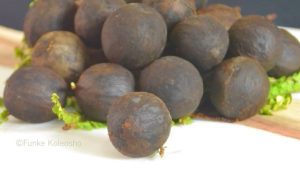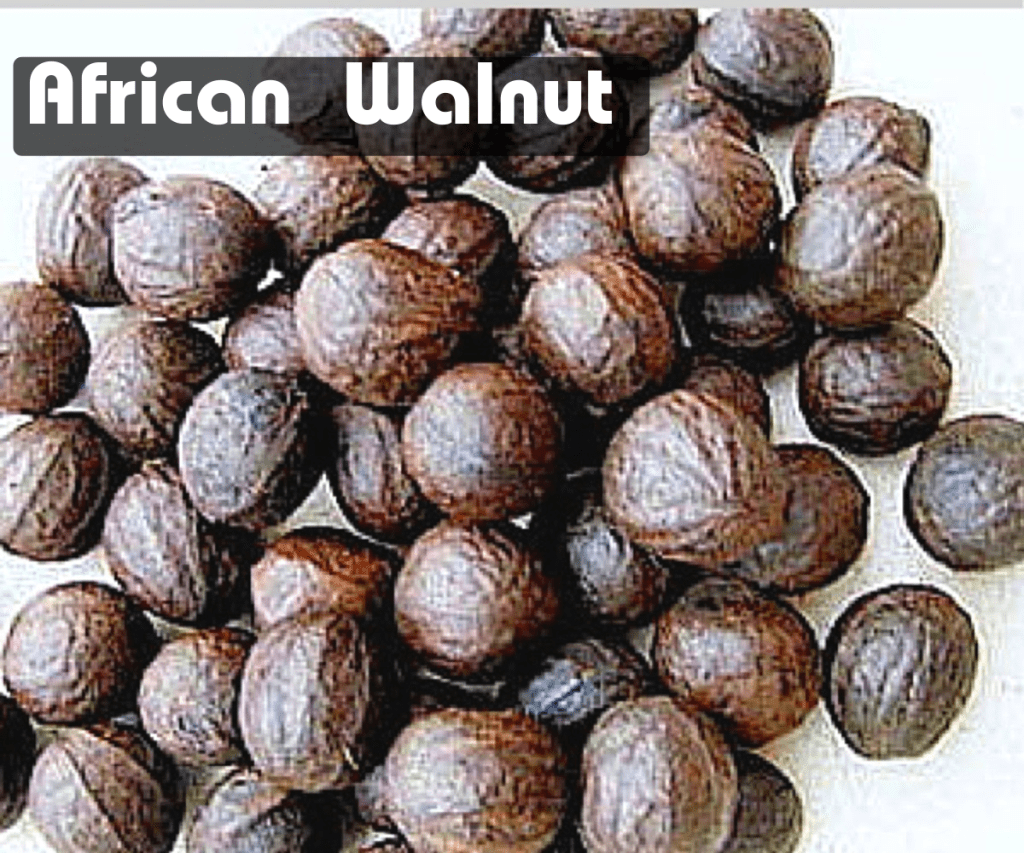We have compiled this educative article on African Walnut to enlighten you on what it is, how to grow, medicinal properties and more.
But before, we get right into it. We believe you may have heard of African Walnut especially as an African.
Preferred Botanical Name: Tetracarpidium conophorum
Preferred Common Name: African Walnut
Local Common Name: African Walnut has different local names in Nigeria but popular in;
- Yoruba as: Asala or Awusa
- Igbo as: Ukpa
Origin Of African Walnut
African walnut, is a predominant plant in West Africa grown mostly for its nut, this nut can be cooked or consumed as snacks.
African walnut is a woody plant of the family Euphorbiaceae and it is cultivated in the tropical regions and widely consumed by Africans.
This nut is a highly consumable food by West Africans in Guinea and Central Africa. Its nut is milk-colored with a black-colored pericarp covering it.
The plant compounds in walnuts are rich and nutritious with highly beneficial health components; they help ward off malaria attacks, treat toothache problems, and others.
Young capsules produced from the climbers are green in color while fully ripe are greenish-yellow.
Walnut plants have broad leaves which are about 53 inches round with slender petioles up to 3 inches long. Their seed testa is hard with a white color cotyledon.
African walnut is believed to have originated in southwestern Nigeria. To grow African Walnut to maturity of seeds may take up 4- 6 months.
Walnuts are perennial plants; they grow along the African coastline.
Nutrients Composition Of African Walnut

Nutritional Values of 100g African Walnuts include the following:
- Calories 315kcal
- Carbohydrates 13.14g
- Protein 24.01g
- Fats 17.39g
- Dietary Fiber 5.99g
Medicinal Properties and Uses Of African Walnut
This is a healthy fruit with many health benefits to the human body. They include:
- Neuroprotective compounds like: omega-3 fatty acids, antioxidants, vitamin E, and folates are present in walnuts.
-
These nutrients help to improve brain health in adults and growing ones.
- Walnuts are great for pregnant mothers because they contain polyunsaturated fatty acids.
- These nutrients prevent unborn babies from developing food allergies.
- Traditional medicine practitioners use leaves of walnuts to treat miscarriages and pregnancy-related issues.
- Eating walnuts before going to bed have been believed to aid better sleep due to the melatonin present in it and tackles some sleep disorders that may likely occur at night.
- It contains effective antioxidants such as tannin, tellimagrandin, flavonol morin, quinine juglone, and polyphenols that prevent the liver from damage against food chemicals and terminate free radicals from the body system.
- Walnuts are a good weight loss choice when added to daily meals.
- Quality fiber, fat, and protein are present in one ounce of walnuts, making a person feel full and satisfied.
- Frequent walnut consumption at least two times a week may prevent breast cancer and pancreatic cancer.
- Walnut fruits are fertility boosters, especially in men, which increases sperm quality. Scientists have proven the fertility potency of walnuts fruits.
- L-arginine is an amino acid in walnuts promotes a healthy heart.
- Frequent consumption of walnuts reduces bad cholesterol in the body ( low-density lipoprotein).
- The trace mineral (manganese) in walnuts occurs naturally with zinc, copper, and iron, which are essential minerals for immune development and functions.
- Walnut leaf extract is another natural antioxidant that plays a good role in regulating menstrual flow.
- It helps to improve proper menstrual flow and inhibit menstrual flaws experienced by several women while menstruating.
- Regular consumption of African walnuts helps reduce the risk of hyperglycemia high blood sugar, which is the main cause of type-1 and type-2 diabetes mellitus.
- Anti-inflammatory properties are present in walnuts, and these properties help prevent bone inflammatory diseases.
How To Grow African Walnut
Growing African walnut requires adequate information. Below are the requirements for planting walnuts.
Yield Information Of African Walnut
A knowledge of output per acre is required for large-scale farming. An acre of walnut plantation yields about 6,00 pounds of nuts.
A well-spaced planting style on an acre of land will contain about 100 trees of walnut.
Nursery and Transplant Requirements Of African Walnut
Transplanting of seedlings can occur after leaves come out. The seedlings are transplanted to the field and spaced at distances of 12 meters.
If irrigation facilities are available, it is advisable to plant at least a month before rainfall so that the seedlings get well established before heavy rains.
Transplant should be covered well with soil and done carefully to avoid shock. Water plants adequately.
Soil and Sun Requirements Of African Walnut
This plant has no special soil requirements; however, soil pH should be about 5.5 to 6.5.
Walnuts are evergreen, and their trees grow up to 25 – 38 meters (approx. 82-125 ft.).
Tropical regions are the most suitable for planting walnuts. It requires good air circulation and drainage.
Watering Requirements Of African Walnut
It should be watered moderately, especially during its beginning growth phase.
Watering reduces as the plant grows big. Avoid overwatering and also avoid keeping the plant too dry.
Planting and Spacing Requirements Of African Walnut
Planting walnuts on a large scale requires enough space to enable proper sunlight.
There is no actual size of farmland for walnut plantation; however, ensure that your farmland can contain enough trees.
Recommended spacing for planting walnuts is a grid spacing of 12m x 12m.
Harvesting Of African Walnut
Harvest mostly begin in late August. On ripening, walnuts fall off to the ground. Nuts are usually found in an enclosed shell.
Storage Of African Walnut
African walnuts are best stored in a cool, dry place. It can last for weeks when stored properly. Avoid moisture and cold to prevent the growth of molds.
Diseases and Pests Of African Walnut
Anthracnose
symptoms are black lesions on leaves, lesions on shoots, the leaf becomes elongated and sunken. It is fungi. Control includes removing debris around plants and space trees.
Blackline Disease
This is a viral disease that causes yellowing and dropping of leaves, and defoliation occurs prematurely. Immediate removal of the plant is advised.
Crown gall
This is a bacterial disease that also affects walnut. Galls grow on roots.
Conclusion
With the above information about African Walnut, we are convinced that you can identify, grow and of course use the fruit in a way that you can maximize all of its nutrients.
